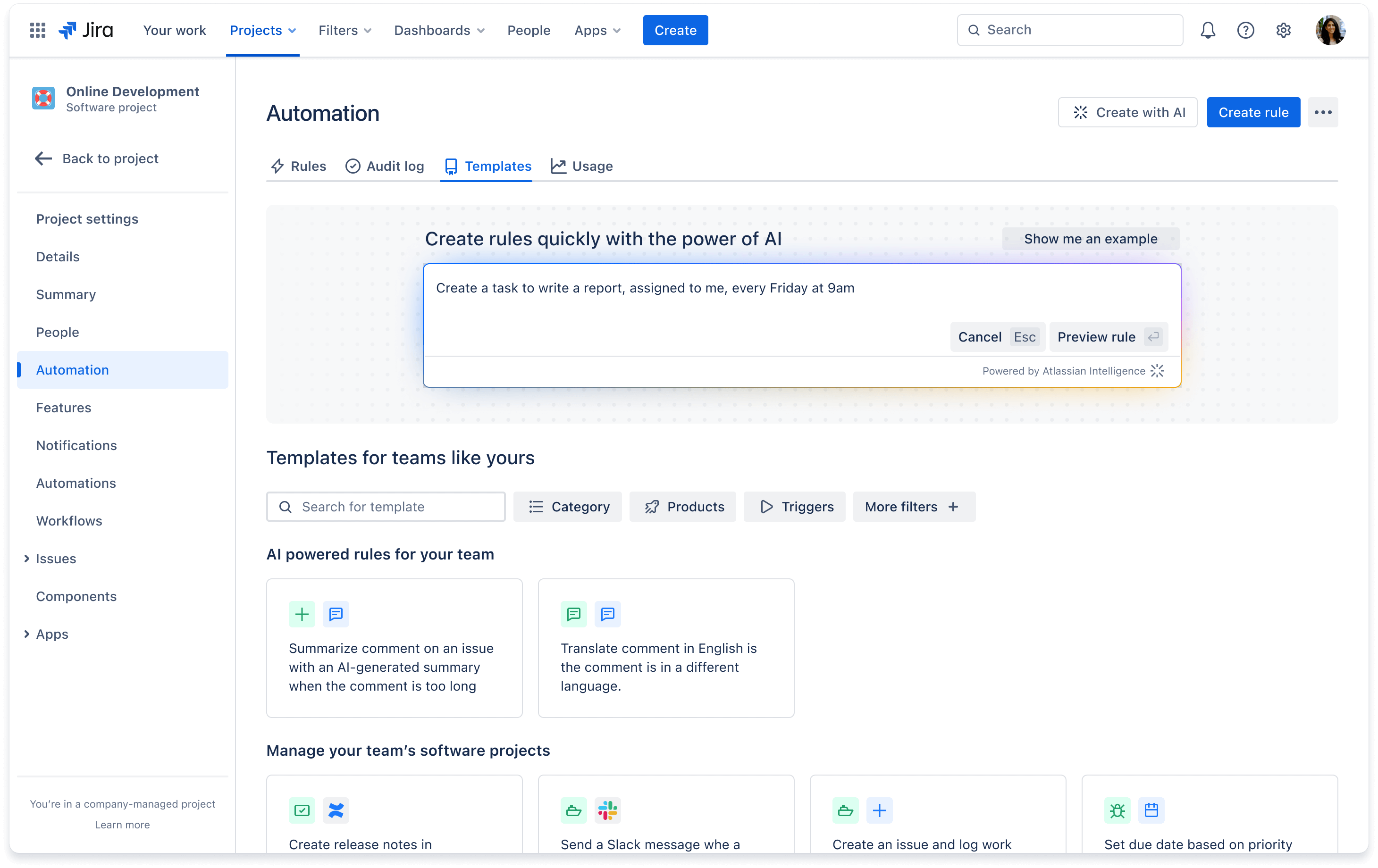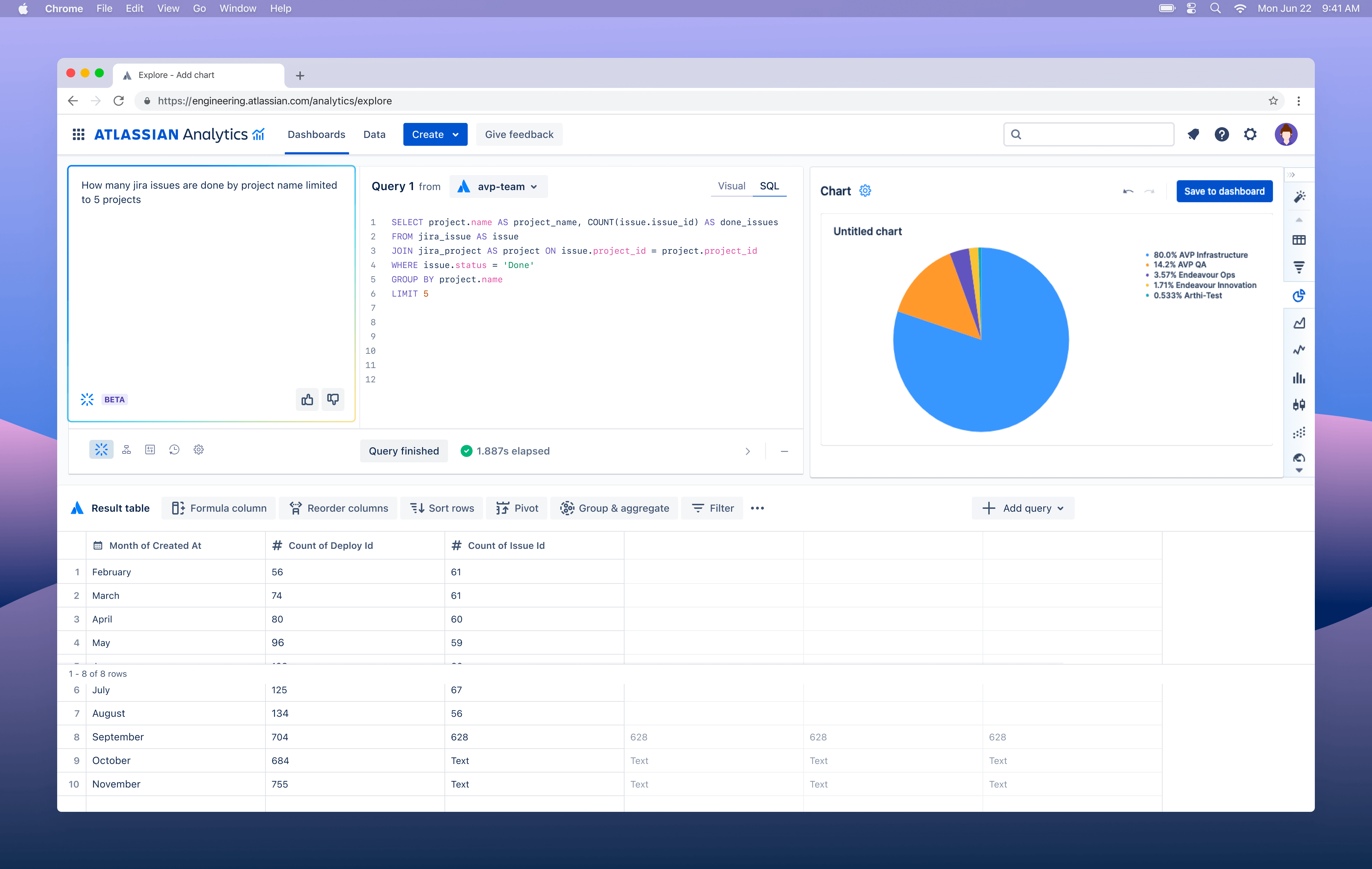Staying ahead means tapping into the wonders of artificial intelligence (AI) solutions within your company. But AI isn’t just used to automate tasks; it empowers your teams to achieve more. Integrating AI-powered features into your workflow encourages teams to work more efficiently and make decisions backed by data-driven insights.
By leveraging advanced AI tools and capabilities like large language models (LLMs), natural language processing (NLP), retrieval augmented generation (RAG), and more, teams can glean valuable insights from data and confidently make informed decisions. AI can streamline processes, enhance productivity, and drive innovation across an organization.
Keep reading to learn more about how to use AI features in your company and how embracing AI solutions within your company can help you stay ahead, take advantage of new opportunities, and drive success.
How to adopt AI features in a company
As businesses increasingly turn to artificial intelligence solutions to optimize processes and drive innovation, understanding how to use AI features becomes even more important. From defining the work and tasks suitable for AI integration to assessing AI’s capabilities and identifying relevant use cases, you’ll need to lay the groundwork before using AI solutions within your company.
Assess AI’s capabilities
Understanding how well AI systems can meet the company’s needs is crucial. Here are steps to assess AI’s capabilities:
- Identify company needs: Understand the company’s specific requirements and objectives. What tasks or processes need improvement or automation? By pinpointing these needs, you can tailor your evaluation to focus on AI solutions that align with your company’s goals.

- Research AI solutions: Explore AI tools and technologies to find systems that specialize in the areas you’ve identified as the company’s priorities. Consider factors like functionality, scalability, compatibility with existing systems, and ease of integration.
- Test them: Try a few AI tools to see how they perform. Do a trial run or a small project to see how well they work in real-life situations. Pay attention to how accurate they are and how fast they work.
- Gather feedback: Solicit feedback from relevant stakeholders within the company, including end-users, IT professionals, and decision-makers. Their insights can provide perspectives on the suitability and effectiveness of AI tools in meeting the company’s needs.
Define the task and work
Adopting AI features within a company requires a clear understanding of the task and underlying work processes. Before integrating AI solutions, it’s crucial to define tasks and outline the specific work involved. This ensures that AI is applied to tasks of limited scope, which don’t require extensive expertise but offer ample opportunity for optimization.
Take, for example, marketing campaigns, where leveraging AI to aid in tasks like crafting emails or website copy can deliver notably better results than tackling an entire campaign at once. This is because AI performs better when given specific context and precise directives, enabling it to generate relevant outputs. Focusing on short, simple tasks, such as composing an email, allows companies to get fast and valuable responses from AI.
Apply AI to specific tasks
By focusing AI efforts on tasks that are well-defined and of manageable scope, organizations can optimize the efficiency and effectiveness of AI utilization. This approach streamlines workflows and enhances the quality of outputs generated by AI systems.
For instance, breaking down complex projects into smaller, more manageable tasks allows for targeted AI assistance, leading to more impactful results. Whether automating repetitive tasks or generating insights from data, applying AI to specific tasks empowers teams to achieve more with greater precision and agility.
Provide enough context in your prompts
Guiding AI systems to perform optimally requires providing sufficient context in prompts. This includes articulating clear instructions and offering relevant background information to help AI tools understand the task. By providing context-rich prompts, organizations can ensure that AI systems generate outputs that align closely with their objectives and requirements.
For example, when requesting AI assistance in drafting an email, providing details such as the target audience, key messaging points, and desired tone can significantly enhance the content’s relevance and quality.
Learn AI’s strengths and weaknesses
Recognizing AI technologies’ strengths and limitations is essential for maximizing their effectiveness and determining when to use them.
AI strengths include:
- Efficiency and speed: AI excels in completing tasks quickly, making it invaluable for accelerating workflow processes.
- Handling large volumes of information: AI adeptly interprets extensive textual data, extracting patterns and insights from spreadsheets to lengthy documents.
- Brainstorming aid: AI stimulates idea generation, overcoming creative blocks and facilitating idea articulation.
- Text formatting: AI proficiently transforms text, from generating SQL queries to structuring blog content.
- Instruction execution: AI executes tasks based on clear instructions and contextual understanding, providing feedback, guidance, and problem-solving assistance.
Unfortunately, AI can’t do it all. AI weaknesses include:
- Deep thinking: AI struggles with tasks requiring profound thinking, collaboration, and complex problem-solving approaches.
- Dependency on context: Accessing and integrating diverse data sources can be challenging for AI, hindering its ability to grasp comprehensive context.
- Inability to execute complex actions: AI cannot perform intricate actions, requiring extensive development efforts for practical implementation.
- Potential for misinformation: AI may generate erroneous or misleading outputs, also known as hallucinations. This requires verification and fact-checking, which can take time.
- Context ignorance: AI may overlook crucial contextual information, which is why it’s so important to provide concise and specific instructions.
Filter out when and how to use AI
To effectively use AI solutions, you’ll need to know when it makes sense to use them and when it doesn’t. Here’s how to discern the best tasks for AI:
- Identify AI’s role in each step: Evaluate each step of your process and determine where AI can help. Recognize tasks where AI excels and those where its capabilities may be limited.
- Consider AI’s strengths: AI is beneficial in tasks such as speeding up the starting process, retrieving knowledge, iterating, improving writing quality, and providing alternative perspectives.
- Acknowledge AI’s limitations: Understand that AI may struggle with tasks requiring deep thinking and generating unique text. It may also have limitations in adding context-specific details to core arguments.
Look for non-obvious use cases
Unusual ideas often lead to exciting discoveries. When using AI in your company, looking for less obvious ways to apply it can bring immense benefits. By thinking creatively and using AI unexpectedly, your company can boost efficiency and find new ways to succeed. Here are a few less-known use cases for AI solutions:
Use multiple capabilities in AI conversations
Incorporating diverse functionalities, such as natural language processing, data analytics, and pattern recognition, gives organizations access to deeper insights, faster information retrieval, and enhanced problem-solving abilities. Leveraging these capabilities makes decision-making processes more comprehensive and effective, driving innovation and strategic growth within the company.

Improve your creative processes
Integrating AI into creative processes can help you find new avenues for innovation and problem-solving within the company. AI tools offer idea generation, content creation, and design optimization capabilities, empowering teams to explore fresh ideas, streamline workflows, and produce high-quality creative outputs.
By incorporating AI into creative processes, organizations can enhance collaboration and accelerate project timelines. From generating ideas to refining content creation, AI provides valuable support in enhancing creativity and driving business success.
Delegate creative mundane tasks
By delegating these repetitive creative tasks to AI systems, you can enhance efficiency, reduce workload, and focus your energy on more strategic and high-value activities within your organization. Determine if the task involves repetitive creative work that doesn’t require deep thinking.
A few tasks you can delegate include:
- Examples and frameworks: Use AI solutions to find examples of how others have tackled similar problems or generate frameworks for common issues. This could include writing SQL queries, developing travel guides, or defining product strategy criteria.
- Storytelling automation: Automate storytelling tasks using AI. AI tools can write user journeys for product presentations or help you visualize complex task sequences.
- Onboarding assistance: If you’re responsible for onboarding new team members, consider creating a conversational AI model that they can interact with to grasp domain-specific knowledge easily.
- Success measurement: Use AI to streamline the process of brainstorming success metrics. Simply prompt AI to define measures of success for specific features or tasks.
Understand AI for low- and high-precision tasks
When performing any set of tasks, some are easier than others and require less accuracy or precision. Low-precision tasks are simpler and don’t require as much detail for AI to handle. Think of basic tasks like writing text or formatting documents.
On the other hand, high-precision tasks are more complex and require extensive guidance for AI to perform correctly. Understanding this difference is important for maximizing AI solutions.
- AI for high-precision tasks: Tasks requiring detailed, original work fall into this category. AI needs significant context and instruction to produce satisfactory results. Even if AI outputs are acceptable, the return on investment (ROI) may not justify using AI, making it more practical to complete these tasks manually. Examples include complex analysis, strategic decision-making, and tasks with high stakes.
- AI for low-precision tasks: Simple tasks like text generation, formatting, basic knowledge retrieval, and improving writing quality can be accomplished with limited context and instruction. These low-precision tasks are routine and mundane, often involving rote work to keep operations running smoothly. While there’s minimal risk if the AI output isn’t perfect, leveraging AI for these tasks can significantly expedite processes and free up time for higher-value activities.
Use AI to navigate ambiguity
Sometimes, not having all the facts is helpful. AI search tools can fill in the blanks by providing a more comprehensive range of answers on a topic. This is especially handy when you’re new to a team, diving into a new problem, or just need more info after a confusing meeting.
If you need help tackling a task or determining what the end result should look like, AI can come to the rescue. Whether you’re learning a new skill or figuring out best practices, AI can guide you in the right direction.